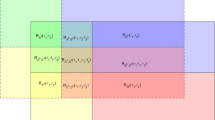Abstract
Three-dimensional (3D) multiple-input multiple-output (MIMO) systems exploit spatial richness and provide another degree of freedom to transmit signals and eliminate spatial interference. Currently, however, there is no 3D codebook for two-dimensional (2D) antenna array MIMO systems with limited feedback. In this paper, based on the existing 2D codebook, we present a limited feedback and transmission scheme for 2D antenna array MIMO systems. In this scheme, the mobile station (MS) has imperfect channel knowledge, and the base station (BS) only acquires partial information relating the channel instantiation. MS must feed back two channel state information (CSI) instances, i.e., the horizontal and vertical CSIs. After receiving the two CSI instances, the BS interpolates a new vertical precoding vector using the vertical CSI. Then, the BS re-constructs a 3D beamforming vector using horizontal and vertical precoding vectors and compensates the reported horizontal channel quality indicator. System level simulation is employed, and the simulation results show that the proposed method improves the system spectral efficiency and the cell-edge SE significantly.







Similar content being viewed by others
References
Baker, M. (2012). From LTE-advanced to the future. IEEE Communications Magazine, 50(2), 116–120.
Lu, X., Tolli, A., Piirainen, O., Juntti, M., & Li, W. (2011). Comparison of antenna arrays in a 3-D multiuser multicell network. In Proceedings of the international conference on communications (pp. 1–6).
Shafi, M., Zhang, M., Moustakas, A. L., Smith, P. J., Molisch, A. F., Tufvesson, F., et al. (2006). Polarized MIMO channels in 3-D: Models, measurements and mutual information. IEEE Journal on Selected Areas in Communications, 24(3), 514–527.
Yong, S. K., & Thompson, J. S. (2005). Three-dimensional spatial fading correlation models for compact MIMO receivers. IEEE Transactions on Wireless Communications, 4(6), 2856–2869.
Dao, M.-T., Nguyen, V.-A., Im, Y.-T., Park, S.-O., & Yoon, G. (2011). 3D Polarized channel modeling and performance comparison of MIMO antenna configurations with different polarizations. IEEE Transactions on Antennas and Propagation, 59(7), 2672–2682.
Baltzis, K. B., & Sahalos, J. N. (2009). A simple 3-D geometric channel model for macrocell mobile communications. Wireless Personal Communications, 51(2), 329–347.
3GPP, TR., 25.996, v9.0.0. (2009). Spatial channel model for Multiple Input Multiple Output (MIMO) simulations.
Kÿosti, P. (2007). Winner II channel models, IST-4-027756 WINNER II, D1.1.2 V1.1. WINNER Project, Technical Report.
Schumacher, L., Pedersen, K., & Mogensen, P. (2002). From antenna spacings to theoretical capacities—guidelines for simulating MIMO systems. In 13th annual IEEE international symposium on personal, indoor and mobile radio communications (pp. 587–592).
Marzetta, T. L. (2010). Non-cooperative cellular wireless with unlimited numbers of base station antennas. IEEE Transactions on Wireless Communications, 9(11), 3590–3600.
Ng, B. L., Kim, Y., Lee, J., Li, Y., Nam, Y.-H., Zhang, J., & Sayana, K. (2012). Fulfilling the Promise of Massive MIMO with 2D active antenna array. In Proceedings IEEE globecom (pp. 691–696).
3GPP, TS., 36.211 V10.1.0. (2011). Evolved universal terrestrial radio access (E-UTRA); Physical Channels and Modulation. March 2011.
Considerations on CSI feedback enhancements for high-priority antenna configurations. Aug. 2011, R1–112420, 3GPP TSG-RAN WG1 # 66.
Caire, G., Jindal, N., Kobayashi, M., & Ravindran, N. (2010). Multiuser MIMO achievable rates with downlink training and channel state feedback. IEEE Transactions on Information Theory, 56(6), 2845–2866.
Peng, Y., Yang, W., Zhu, Y., & Kim, Y.-I. (2013). An enhanced link adaptation scheme based on cooperative interference prediction for MIMO-OFDM systems. Wireless Personal Communications, 70(2), 519–535.
Jindal, N. (2006). MIMO broadcast channels with finite-rate feedback. IEEE Transactions on Information Theory, 52(11), 5045–5060.
Wang, C., Au, E. K. S., Murch, R. D., Mow, W. H., Cheng, R. S., & Lau, V. (2007). On the performance of the MIMO zero-forcing receiver in the presence of channel estimation error. IEEE Transactions on Wireless Communications, 6(3), 805–810.
Li, P., Paul, D., Narasimhan, R., & Cioffi, J. (2006). On the distribution of SINR for the MMSE MIMO receiver and performance analysis. IEEE Transactions on Information Theory, 51(2), 271–286.
3GPP TS 36.213 V11.1.0. (2012). Evolved universal terrestrial radio access (E-UTRA). Physical layer procedures.
Love, D. J., Heath, R. W., Jr., & Strohmer, T. (2003). Grassmannian beamforming for multiple-input multiple-output wireless systems. IEEE Transactions on Information Theory, 49(10), 2735–2747.
Song, H., Kwan, R., & Zhang, J. (2011). Approximations of EESM effective SNR distribution. IEEE Transactions on Communications, 59(2), 603–612.
Peng, Y., Yang, W., Zhu, Y., & Kim, Y.-I. (2012). A novel CSI feedback method for dynamic SU/MU MIMO adaptation. Wireless Personal Communications. doi:10.1007/s11277-012-0926-6.
Raja, M., Muthuchidambaranathan, P., & Nguyen, H. H. (2013). Transceiver design for MIMO systems with improper modulations. Wireless Personal Communications, 68(2), 265–280.
Acknowledgments
This work was supported by the Natural Science Foundation of China under Grant (51274018), the National Science & Technology Pillar Program (2013BAK06B03), and National Mobile Communications Research Laboratory (2010D11), Southeast University.
Author information
Authors and Affiliations
Corresponding author
Rights and permissions
About this article
Cite this article
Peng, Y., Yang, W., Zhu, Y. et al. Transmission Scheme for 2D Antenna Array MIMO Systems with Limited Feedback. Wireless Pers Commun 75, 759–774 (2014). https://doi.org/10.1007/s11277-013-1390-7
Published:
Issue Date:
DOI: https://doi.org/10.1007/s11277-013-1390-7




